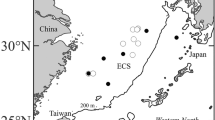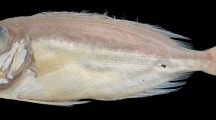Abstract
A new species of dicyemid mesozoan is described from a cuttlefish Sepia latimanus Quoy and Gaimard collected off Nago, Naha and Onnason, Okinawa Islands, Ryukyu Islands, Japan. Dicyemennea ryukyuense n. sp. is a large species that reaches about 5 mm in length. The vermiform stage is characterised by 23 peripheral cells, a conical calotte and an axial cell that extends to the base of the propolar cells. The infusoriform embryo consists of 37 cells; two nuclei are present in each urn cell and the refringent bodies are solid. In the type of reproductive strategy, rhombogens of D. ryukyuense form a small number of infusorigens and produce a relatively large number of gametes per infusorigen. In the family Dicyemidae, Dicyemennea Whitman, 1883 is the largest group after Dicyema von Kölliker, 1849. Other dicyemid species, including those belonging to Dicyema, were not detected. Dicyemids have never previously been detected in cephalopods living on corals and rocks off the Ryukyu Islands, even though they are benthonic in habitat. This is the first report of a dicyemid mesozoan from S. latimanus and also from off the Ryukyu Islands. S. latimanus inhabits coral reefs, often swimming over the coral but usually lying on the sandy bottom. Dicyemids cannot possibly infect cephalopods which live exclusively over coral and rock.
Similar content being viewed by others
References
van Beneden, É. (1876). Recherches sur les DicyÉmides, survivants actuels d’un embranchement des MÉsozoaires. Bulletins de l’AcadÉmie Royale de Belgique, 42, 3–111.
van Beneden, É. (1882). Contribution à l’histoire des DicyÉmides. Archives de Biologie, Paris, 3, 195–228.
Furuya, H. (1999). Fourteen new species of dicyemid mesozoans from six Japanese cephalopods, with comments on host specificity. Species Diversity, 4, 257–319.
Furuya, H. (2005). Three new species of Dicyema (Phylum Dicyemida) from Amphioctopus kagoshimensis (Mollusca: Cephalopoda: Octopodidae). Species Diversity, 10, 231–247.
Furuya, H. (2006). Three new species of dicyemid mesozoans (Phylum Dicyemida) from Amphioctopus fangsiao (Mollusca: Cephalopoda), with comments on the occurrence patterns of dicyemids. Zoological Science, 23, 105–119.
Furuya, H., & Hochberg, F. G. (1999). Three new species of Dicyema (Phylum Dicyemida) from cephalopods in␣the Western Mediterranean. Vie et Milieu, 49, 117–128.
Furuya, H., Hochberg, F. G., & Tsuneki, K. (2001). Developmental patterns and cell lineages of vermiform embryos in dicyemid mesozoans, Biological Bulletin, 201, 405–416.
Furuya, H., Hochberg, F. G., & Tsuneki, K. (2003a). Calotte morphology in the phylum Dicyemida: niche separation and convergence. Journal of Zoology, 259, 361–373.
Furuya, H., Hochberg, F. G., & Tsuneki, K. (2003b). Reproductive traits of dicyemids. Marine Biology, 142, 693–706.
Furuya, H., Hochberg, F. G., & Tsuneki, K. (2004). Cell number and cellular composition in infusoriform larvae of dicyemid mesozoans (Phylum Dicyemida). Zoological Science, 21, 877–889.
Furuya, H., Ota, M., Kimura, R., & Tsuneki, K. (2004). The renal organs of cephalopods: a habitat for dicyemids and chromidinids. Journal of Morphology, 262, 629–643.
Furuya, H., & Tsuneki, K. (2003). Biology of dicyemid mesozoans. Zoological Science, 20, 519–532.
Furuya, H., & Tsuneki, K. (2005). A new species of dicyemid mesozoan (Phylum Dicyemida) from Sepioteuthis lessoniana (Mollusca: Cephalopoda), with notes on Dicyema orientale. Species Diversity, 10, 45–62.
Furuya, H., Tsuneki, K., & Koshida, Y. (1992a). Two new species of the genus Dicyema (Mesozoa) from octopuses of Japan with notes on D. misakiense and D.␣acuticephalum. Zoological Science, 9, 423–437.
Furuya, H., Tsuneki, K., & Koshida, Y. (1992b). Development of the infusoriform embryo of Dicyema japonicum (Mesozoa: Dicyemidae). Biological Bulletin, 183, 248–257.
Furuya, H., Tsuneki, K., & Koshida, Y. (1993). The development of the hermaphroditic gonad in four species of dicyemid mesozoans. Zoological Science, 10, 455–466.
Furuya, H., Tsuneki, K., & Koshida, Y. (1997). Fine structure of a dicyemid mesozoan, Dicyema acuticephalum, with special reference to cell junctions. Journal of Morphology, 231, 297–305.
Hochberg, F. G. (1990). Diseases caused by protistans and mesozoans. In O. Kinne (Ed.), Diseases of marine animals, vol. III (pp. 47–202). Hamburg: Biologische Anstalt Helgoland.
Huffard, C. L., & Hochberg, F. G. (2005). Resurrection of the genus Amphioctopus (Mollusca: Octopodidae) and description of a new species in the Hawaiian Archipelago. Molluscan Research, 25, 113–128.
Kalavati, C., Narasimhamurti, C.C., & Suseela, T. (1978). A new species of Dicyemennea, D. coromandelensis n. sp. from Sepia elliptica Hoyle. Proceedings of the Indian Academy of Sciences (Animal Sciences), 87, 161–167.
Kalavati, C., Narasimhamurti, C.C., & Suseela, T. (1984). Four new species of mesozoan parasites (Mesozoa: Dicyemidae) from cephalopods of Bay of Bengal. Proceedings of the Indian Academy of Sciences (Animal Sciences), 93, 639–654.
McConnaughey, B. H. (1949). Dicyema sullivani, a new mesozoan from Lower California. Journal of Parasitology, 35, 122–124.
Nesis, K. N. (1982). Cephalopods of the world (pp. 103–107). New Jersey: T. F. H. Publications Inc.
Nouvel, H. (1932). Un Dicyémide nouveau de poulpe Dicyemennea lameerei n. sp. Bulletin de la Société Zoologique de France, 57, 217–223.
Nouvel, H. (1933). Recherches sur la cytologie, la physiologie et la biologie des Dicyémides. Annales de L’Institut Océanographique, Monaco, 13, 165–255.
Nouvel, H. (1937). Recherches sur les nématogènes fondateurs des Dicyémides. Bulletin Biologique de la France et de la Belgique, 71, 374–392.
Nouvel, H. (1947). Les Dicyémides 1re partie: systématique, générations, vermiformes, infusorigène et sexualité. Archives de Biologie, Paris, 58, 59–220.
Nouvel, H. (1948). Les Dicyémides. 2e partie: infusoriforme, tératologie, spécificité du parasitisme, affinités. Archives de Biologie, Paris, 59, 147–223.
Nouvel, H., & Nakao, Y. (1938). Dicyémides du Japon. Bulletin de la Société Zoologique de France, 63, 72–80.
Short, R. B., & Damian, R. T. (1966). Morphology of the infusoriform larva of Dicyema aegira (Mesozoa: Dicyemidae). Journal of Parasitology, 52, 746–751.
Short, R. B., & Hochberg, F. G. (1969). Two new species of Dicyema (Mesozoa: Dicyemidae) from Kaikoura, New Zealand. Journal of Parasitology, 55, 583–596.
Wagener, G. R. (1857). Über Dicyema Kölliker. Archiv fÜr Pathologische Anatomie und Physiologie, 1857, 354–364.
Whitman, C. O. (1883). A contribution to the embryology, life history, and classification of the dicyemids. Mittheilungen aus der Zoologischen Station zu Neapel, 4, 1–89.
Acknowledgements
I should like to express my thanks to Dr Euichi Hirose of the University of the Ryukyus, Dr Tohru Iseto of the Kyoto University Museum and Ms Natsumi Kaneko of the University of the Ryukyus for their kind help in collecting cephalopod specimens. I should also like to express my gratitude to Dr Kazuhiko Tsuneki of Osaka University for his critical reading of the manuscript and valuable advice. This study was supported by grants from the Nakayama Foundation for Human Science, the Research Institute of Marine Invertebrates Foundation and the Japan Society for the Promotion of Science (research grant no. 14540645).
Author information
Authors and Affiliations
Corresponding author
Rights and permissions
About this article
Cite this article
Furuya, H. A new species of Dicyemennea Whitman, 1883 (Phylum Dicyemida) from Sepia latimanus (Mollusca: Cephalopoda: Decapodidae) off Okinawa, Japan. Syst Parasitol 65, 205–213 (2006). https://doi.org/10.1007/s11230-006-9048-4
Received:
Accepted:
Published:
Issue Date:
DOI: https://doi.org/10.1007/s11230-006-9048-4




